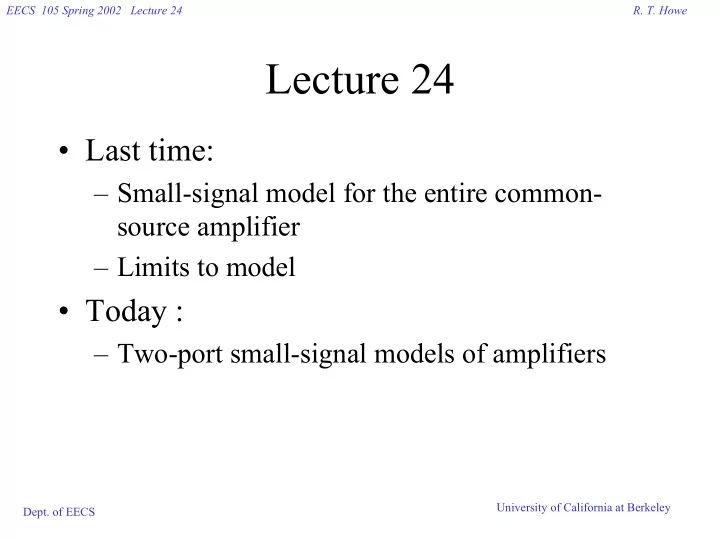

EECS 105 Spring 2002 Lecture 24 R. T. Howe Lecture 24 • Last time: – Small-signal model for the entire common- source amplifier – Limits to model • Today : – Two-port small-signal models of amplifiers University of California at Berkeley Dept. of EECS
EECS 105 Spring 2002 Lecture 24 R. T. Howe Generalized Amplifier University of California at Berkeley Dept. of EECS
EECS 105 Spring 2002 Lecture 24 R. T. Howe Amplifier Terminology Sources : signal, its source resistance, and bias voltage or current Load : use resistor in Chap. 8, but could be a general impedance Port: a pair of terminals across which a voltage and an associated current are defined source, load: “one port” amplifier: “two port” University of California at Berkeley Dept. of EECS
EECS 105 Spring 2002 Lecture 24 R. T. Howe Amplifier Biasing Select V IN (or I IN ) to set the DC device current to equal the supply current I SUP . DC output current I OUT = DC output voltage V OUT = Small-signal source voltage or source current results in small-signal device current i d � University of California at Berkeley Dept. of EECS
EECS 105 Spring 2002 Lecture 24 R. T. Howe One-Port Models (EECS 40) University of California at Berkeley Dept. of EECS
EECS 105 Spring 2002 Lecture 24 R. T. Howe Small-Signal Two-Port Models We assume that input port is linear and that the amplifier is unilateral : The output port : depends linearly on the current and voltage at the input and output ports University of California at Berkeley Dept. of EECS
EECS 105 Spring 2002 Lecture 24 R. T. Howe Math 54 Perspective Can write linear system of equations for either i out or v out in terms of two of i in , v in , i out , or v out : possibilities are = α + α i v v out 1 in 2 out = α + α i i v out 3 in 4 out = α + α v v i out 5 in 6 out = α + α v i i out 7 in 8 out What is physical meaning of α 1 ? of α 6 ? University of California at Berkeley Dept. of EECS
EECS 105 Spring 2002 Lecture 24 R. T. Howe EE Perspective Four amplifier types: determined by the output signal and the input signal … both of which we select (usually obvious) Voltage Current Transconductance Transresistance We need methods to find the 6 α i parameters for the four models and equivalent circuits for unilateral two ports University of California at Berkeley Dept. of EECS
EECS 105 Spring 2002 Lecture 24 R. T. Howe Two-Port Small- Signal Amplifiers University of California at Berkeley Dept. of EECS
EECS 105 Spring 2002 Lecture 24 R. T. Howe Input Resistance R in Looks like a Thevenin resistance measurement, but note that the output port has the load resistance attached v t = R in i R removed , t S R attached L University of California at Berkeley Dept. of EECS
EECS 105 Spring 2002 Lecture 24 R. T. Howe Output Resistance R out Looks like a Thevenin resistance measurement, but note that the input port has the source resistance attached v t = R out i R removed , t L R attached S University of California at Berkeley Dept. of EECS
Recommend
More recommend